Next stop in our travels was Italy – in particular, Brindisi, Italy, and the area nearby. We picked this area partly because it was one of the few places in Italy we could get to by ferry (ferry being the cheapest way to get from Greece to Italy). It also happened to be the closest port in Italy we could reach by ferry, which worked out perfectly when we also discovered that there is a well known wine region right outside Brindisi called Puglia.
After getting off the ferry that I talked about in the last blog (where we slept in the “poor man’s seats” 😂) we spent one night in Brindisi before picking up a rental car and heading out into the countryside. A half hour drive later we found ourselves arriving in the small village of Rinella, where we stayed in an Airbnb on the land of a character named Franco.
Franco was a warm and welcoming host who lived on a small farm full of olive and peach trees, tomato vines, and puppy dogs. He invited us in for a farm fresh lunch before we could even unload our bags and for no additional charge what followed was a four course meal full of veggies from his garden and fresh pasta from the nearby town. Two of his friends, Pisso and Titsiana, also joined us for the meal, and together the three of them formed a marvelous Italian trio: loud and curious, warm and inviting, arguing amoungst each other in Italian one minute and laughing joyously the next. It was the perfect introduction to Italy.

Fresh spaghetti with a sauce made from oysters from the nearby sea and tomatoes picked earlier that day. The green drink in the glasses – easily the worst drink we’ve had this trip 😂. It tasted like someone mixed two flavors of koolaid that shouldn’t go together and added a bag of sugar to cover it up 😆 – the food though, fantastic!
At the end of the meal Franco walked over to a cabinet nearby and walked back with an armful of items – pottery, statues, coins. As he placed them on the table in front of his he told us that these were all things that he had found while digging holes to plant palms in his backyard. As we began looking at them, we quickly realized that these items were the same type of things you see in the museums around many parts of Europe – a coin with Ceasar’s face on it, an old clay pitcher, a terra-cotta face – y’all – his backyard was full of items from the old Roman Empire. Not surprisingly, he said his neighbors had found similar items as well. How crazy is that?

Objects found in Franco’s backyard from old Roman times – note how in tact they are! The small pitcher didn’t even have a chip!
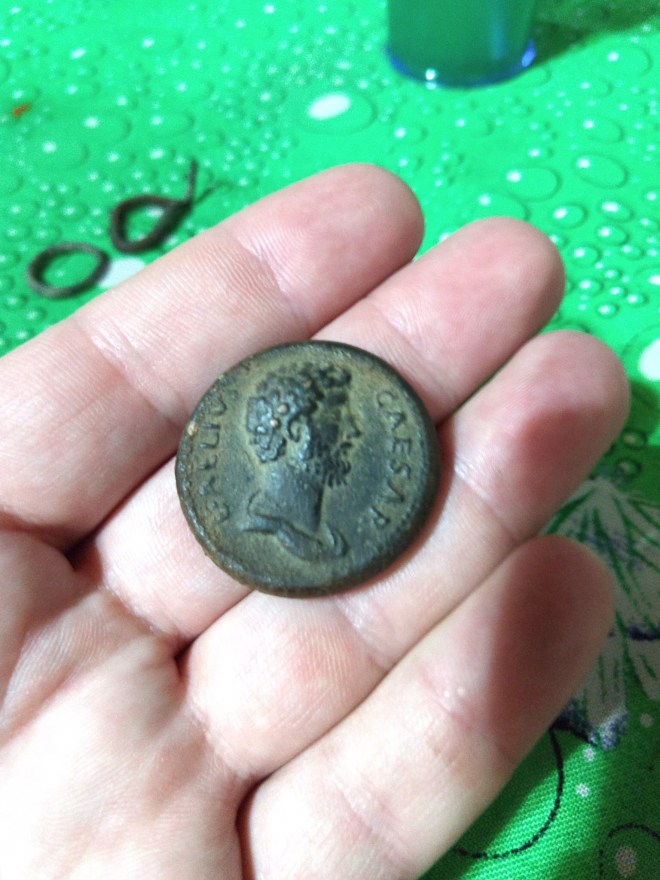
A close up of the coin. It’s a little blurry, but still easy to read. Aelius Caesar – I looked it us and it’s from 136-138 AD.
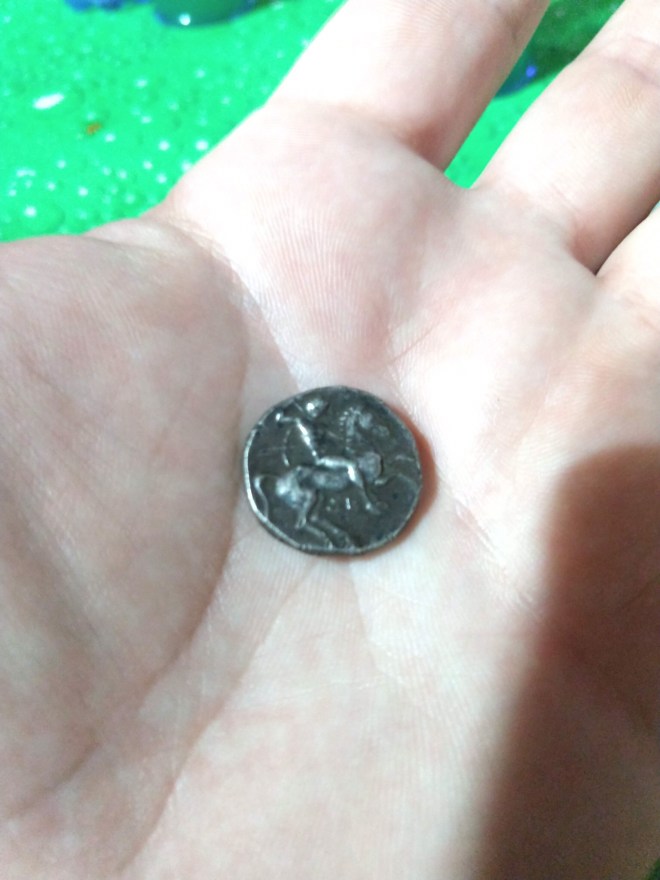
Greek didrachm from third century BC – talk about evidence of trade (well, and also, southern Italy was once inhabited by Greeks). Not to mention that this coin was found in the same area as the above coin from 400ish years later! How crazy!
Being near Puglia, we spent much of the rest of our time visiting vineyards. It was in this area that we got a new view of the term “house wine.” We’d known that in various countries throughout Europe you could order the “house wine” at restaurants for much cheaper than any other wine. It usually comes straight from the barrel or a sort of tap and you are able to purchase it by the quarter, half, or full liter. They bring out to you in a pitcher and, yes, sometimes it is actually cheaper than water. I’d always envisioned the reason for the wine being so cheap was that each restaurant was fermenting their own wine (which many of them do), but what I didn’t realize is that this “house wine” or “table wine” is able to be purchased directly from many of the vineyards for unbelievable prices. I’d assumed that prices like that weren’t possible unless a business had a relationship with a vineyard and was buying in bulk, but alas, any average person can walk into one of these vineyards and purchase a five liter container of wine which is then able to be refilled for around $1.20 euro a liter. The set up is quite gas station like with people standing in line to have their containers pumped full. Below is a good look at a filling station, followed by a picture of people standing in line at one of the more popular vineyards.

The filling station, with pre filled containers of the rose wine ready to be snatched up.
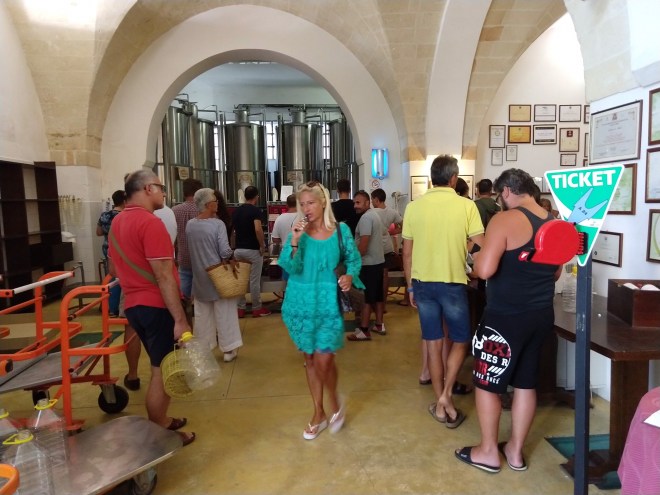
Take your ticket and wait to fill your containers. We’d stopped in for a tasting and there was quite a line in that area too!
Going into wine tasting in Italy, we feared it might not be our favorite region. Pretty much the only exposure we’d had to Italian wines were the Chiantis from around Tuscany, and they aren’t the favorite of either of us. Upon our first tastes in Puglia, we found ourselves pleasantly surprised. Instead of Chiantis, we instead found Primitivos (equivalent in vine DNA to a Zinfandel), Negroamaros, and Salice Solentinos (a DOC status blend that is majority negroamaro grapes). Though Primitivos were our overall favorite, we found some tasty wines in all categories of which we were fans.
The picture above of the refilling line is at a vineyard called Produttori Vini Manduria. We forgot to take pictures of the wine, but they had several good ones (as evidenced by all the people there!). We bought a bottle called Lyrica (a Primitivo) that I was a huge fan of – very balanced with fruity hints and oak that was present, but subtle, like many other wines stored in the big big barrels we’ve tried. Overall, they were probably our third favorite place we visited in the area (with spots one and two being tied by Paolo Leo and Felline that I talk about below). Though we forgot to get pictures, they are certainly worth keeping in mind if you come across any of their products back home.
Below are some of our other favorite wines we had. Like many of our other blogs with wine, these are here to help us remember for the future, so feel free to skip ahead if it doesn’t interest you!

A primitivo from Cantore Di Castelforte
At $5 a bottle (though significantly more expensive than that if you find it in the States) we really enjoyed this one. It wouldn’t make the top of our list of wines we tried, but for the price it was certainly a favorite.

Giravolta (a Primitivo) from Felline
We loved this one. Actually, we loved nearly all of the wines from this vineyard. This vineyard in particular pays extra attention to the type of soil their grapes are grown in and they showcase the different soils in their tasting room. It was interesting to try the different wines next to each other that are made from the same varietal of grapes, but grown in different soils. Not to mention that their winemaker was quite good at creating a balance of flavors in every varietal and blend we tried. The Giravolta was my favorite that we tried and the Dunico (below) was Kirk’s favorite (it had lots of time in oak – Kirk loves the intensity).

Dunico from Felline
A final wine worth noting that we tried in Felline was a wine made exclusively from Sussumaniello grapes. This was the only place we saw a wine made from 100% Sussumaniello and it was certainly interesting! Upon first smell and sip I found my taste buds encountering a very familiar flavor. After pondering for some time, it finally came to me – Twizzlers, the original kind – that was the taste on my tongue. Though this bottle of wine wouldn’t be my first pick, it was certainly interesting and worth trying if you ever encounter it!
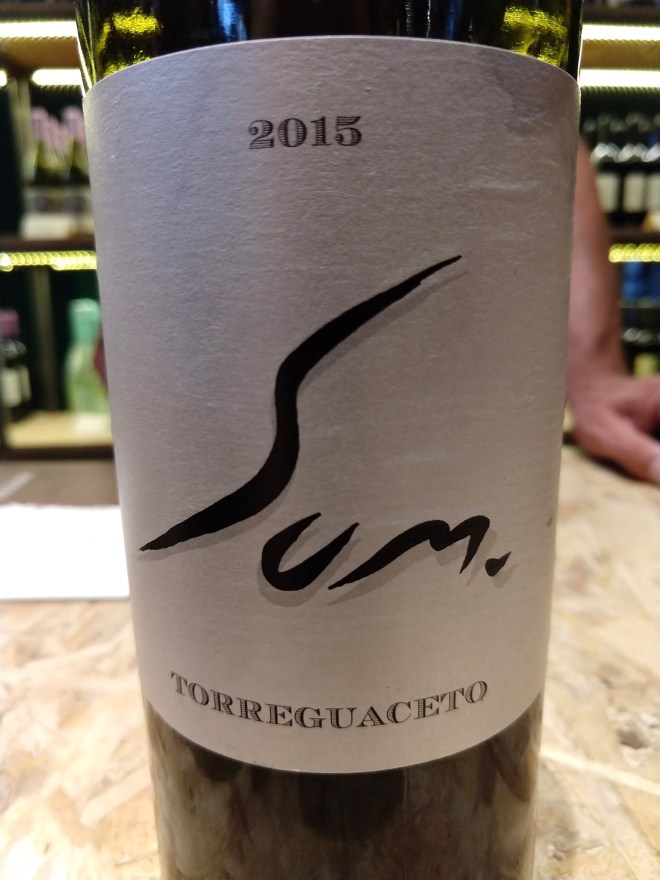
Sum of Felline – 100% Sussumaniello grapes
After we finished our tasting at Felline, we began chatting with the man who had been helping us and learned that he was actually the owner of the vineyard. He was a soft spoken, humble man who ended up telling us stories about his father, the previous owner of the vineyard. From what we learned, his father was a well loved and trusted man in the village who always wanted to help people when he could. The son told us that back in the day, when his father encountered people in the village who were trying to sell their grape harvest, but were having trouble doing so, he would offer to buy their grapes even when he had run out of space to store them.
The son then took us down in the cellar and showed us the lines on the wall from when his father had turned the entire room into an area to ferment the grapes because he had run out of space in the cellar chambers. Wine went nearly to the ceiling, covering the bottom half of the staircase leading down into the room. The cellar would have essentially been a swimming pool of wine during that time. Can you imagine? 😂 Below is a picture of one hallway of the cellar, though it came out too dark for you to see the lines on the wall 😂.

The cellar in Felline where wine once filled the halls – how crazy!
A couple of days after visiting Felline we encountered another vineyard at which we loved nearly every wine we tried. The name of the vineyard was Paolo Leo. A wine enthusiast who had just moved from Argentina to Italy was our tasting guide at Paolo Leo and we had a fun time chatting with her about wines we tried in her home country and there in Italy. What a small world.
Below are two wines we remembered to get pictures of – we actually ended up buying three bottles from here (two small and one big), one of which made it all the way to Spain with us 😂. We tend to buy at least one bottle of wine when the tasting is free, and since so many in this region do free tastings, we ended up with 7 bottles by the time left 😬 😂. I’m sad we won’t be able to get many of these at home. Not to mention that though prices in Italy are usually in the $8-10 range for a really good bottle of wine (and good bottles can be found $4-5), at home those same bottles run anywhere from $20-$35. It’s quite a difference!
This first picture below is of a white wine we tried and bought. The smell of peach coming off this wine made you feel like you were in an orchard. The taste was light and refreshing. It definitely stood out amongst white wines we’d sampled.

Fiano from Paolo Leo
The second wine pictured below was our favorite at Paolo Leo. Though we didn’t originally buy a bottle of it because we opted to instead buy a bottle we hadn’t tried, we went back at the end of the day for this Orfeo. For wine tasting days, we usually ate in and used our food budget for visiting wineries, and this particular day, when all the other vineyards we tried to visit ended up being closed, we headed back to Paulo Leo to use our budget on something we knew we loved (that’s really how we ended up with three bottles from there, we went back! 😂).
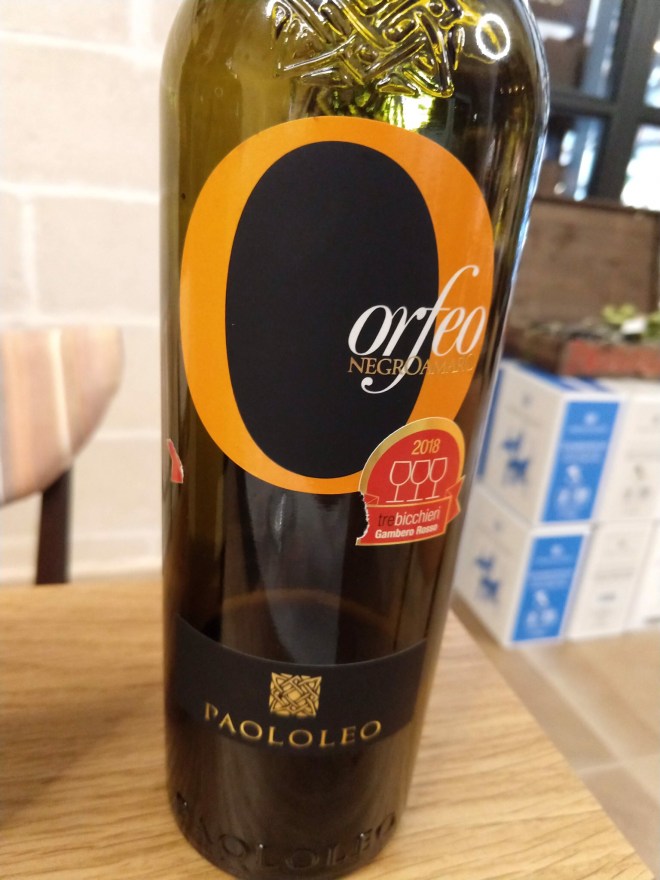
Orfeo – pretty easy to find online in the States, but it’s closer to $20 there. We definitely recommend it if you find it!
A final vineyard that I think is worth mentioning is one called Leone De Castris. Though we were disappointed to find that they weren’t offering tastings when we went (possibly because we didn’t have a reservation?) we bought a small bottle at their shop of one of their more affordable wines and we were very pleasantly surprised. They were well known in the region for their “Five Roses” rose wine, but the Salice Salentino we tried was also fantastic. I have a feeling many of their other wines are equally great if you find them in the States.
As far as the rest of our time in this region, well, it was great. Below are a couple of pictures of fruits Franco shared with us. It was my first time having a fresh fig and y’all ❤️! I love fresh figs! Dried figs are sweet, but, well, dried. Fresh figs are almost like having a ready made jam hanging from a tree. Fresh, sweet, firm enough to just bite into while also soft enough to spread, and with the prefect crunch from the little seeds. I’ve decided I need a fig tree when we get home…do those grow at home?
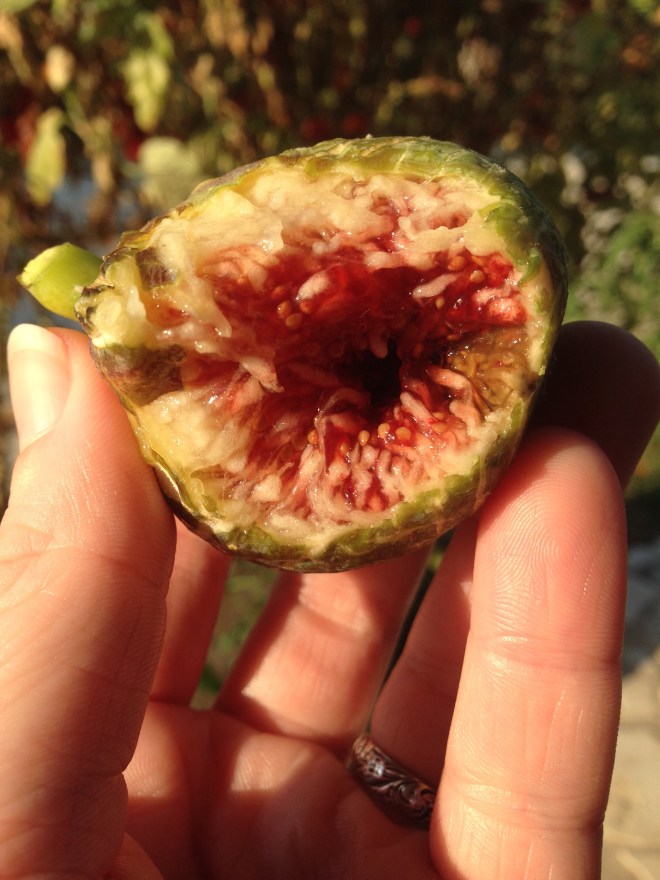
Fresh fig

One of the several bowls of figs Franco shared with us. Ever wonder why Adam and Eve are always pictured with fig leaves as clothes? It’s because fig leaves are huge!
Franco also introduced us to a new fruit. In the grocery stores in Greece and Italy we saw lots of stands filled with an unfamiliar site that appeared to us as squashes. A food the size of a butternut squash that has bright yellow or dark green skin always sat next to the watermelons (sometimes in the same bin). One day Franco brought us our slices of one of the yellow ones and boy were we surprised. It was a melon – a very very sweet one! It had the sweetness and stronger taste of melon like a cantaloupe, but was closer to a honeydew in flavor – Mmmm, we’ve since bought three of our own 😂 (I’m actually eating one as I type this!).
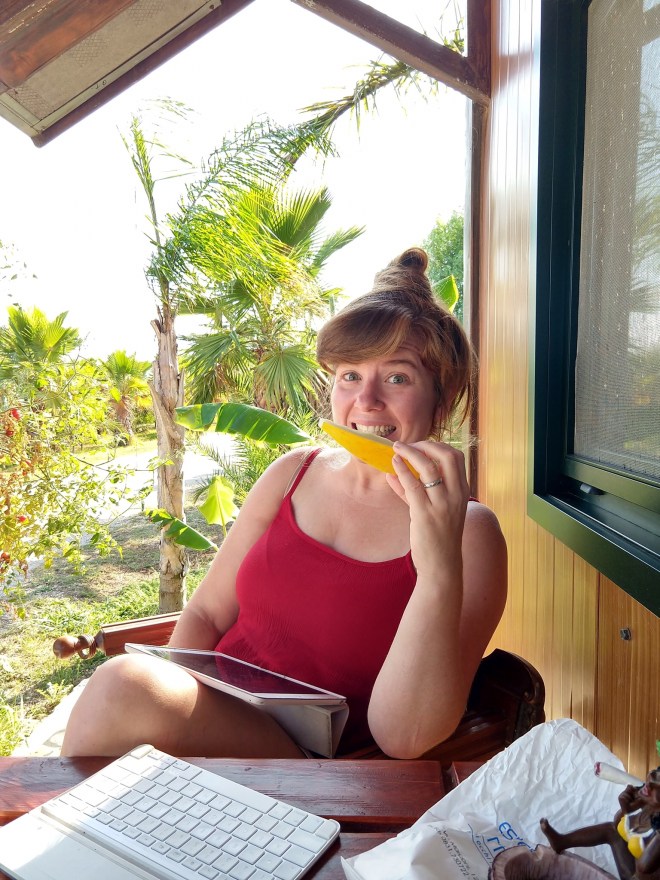
Me with a piece of the melon sitting outside our Airbnb at Franco’s
After Kirk took this picture I then looked at him and loved the way the yellow looked with his blue shirt and eyes so I took a photo of him with the melon too 🙂
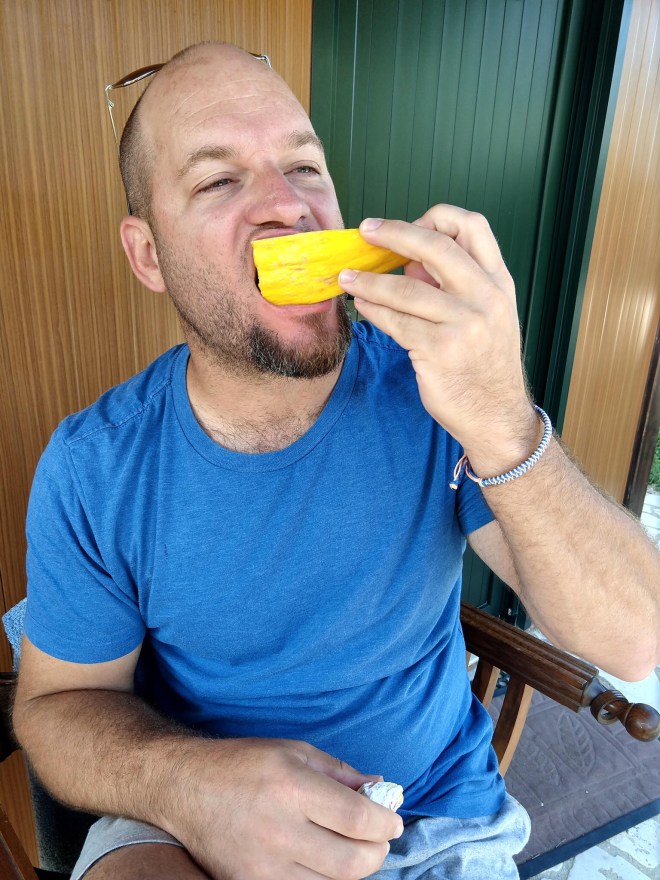
🙂
When we weren’t visiting vineyard in the area, we often set off exploring towns nearby. One day we headed into a town named Ostuni that is known for it’s white washed old city center. We ate lunch and wandered around with plenty of other tourists there. With all it’s charm, it was no surprise that so many people stopped in for a visit!

The white city center on a hill next to the rest of the town.
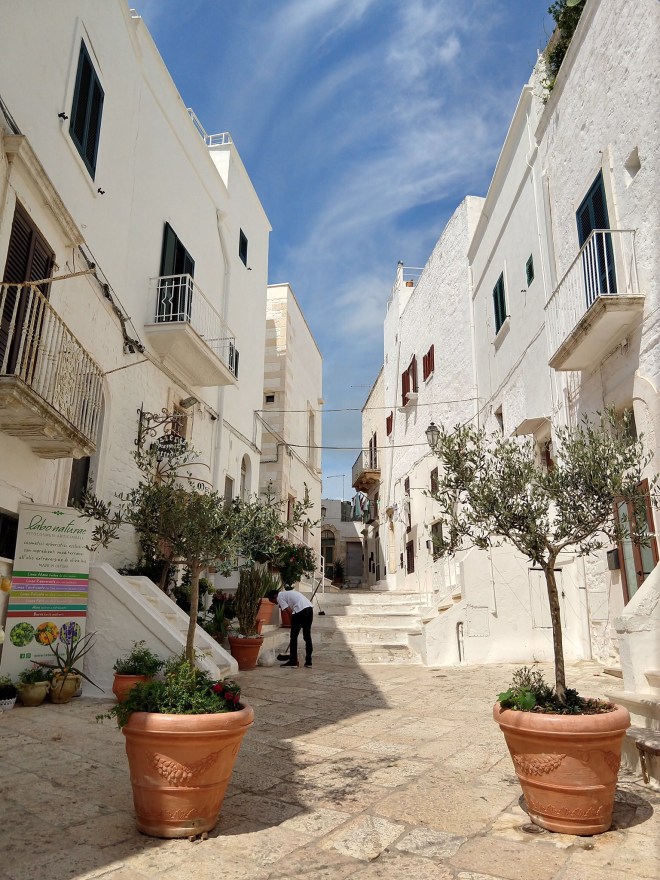
Inside the old city

Walking down an alleyway that led to the edge of the city. Look at those cobblestones and street lamps!
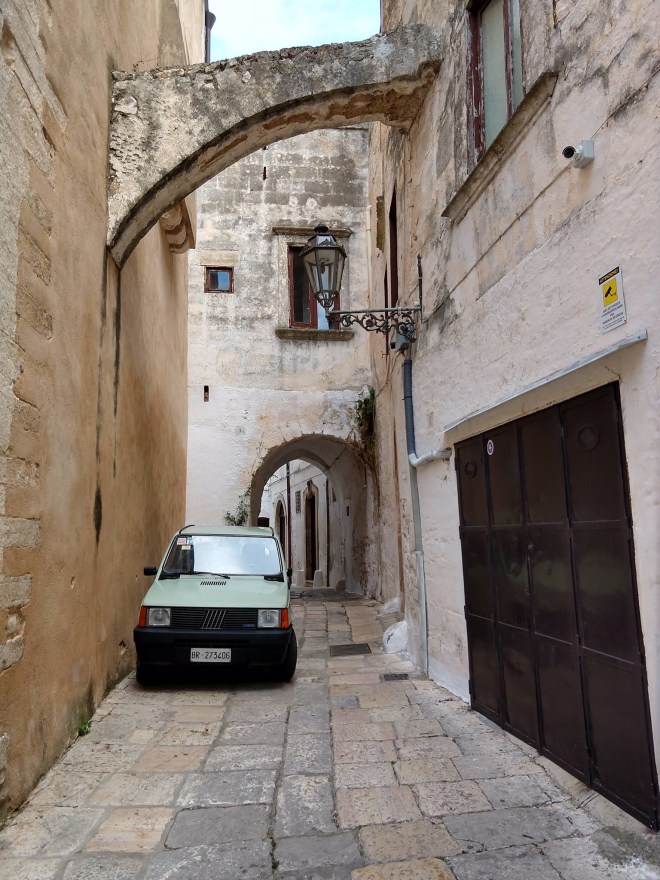
There were plenty of charming alleyways and awnings through out the city. I even loved this old mint colored car parked on the tiny street of the town.

Vintage shop in the alley, tourists looking for good finds.
Our final day in Puglia/the area around Brindisi we spent at a third attraction in the area, the beach. There are miles and miles of turquoise beaches in this area of Italy and locals and tourists alike flock to them throughout the week and especially on the weekend. We opted for a less visited beach that was filled with more rocks than sand, and we had a lovely time laying around and reading.
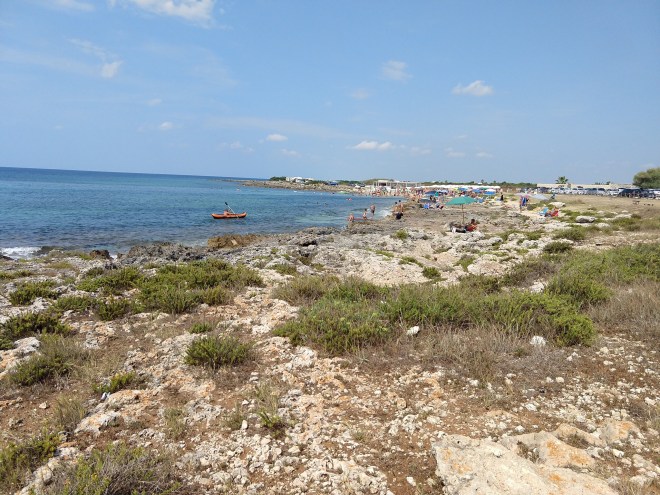
Walking up to the beach
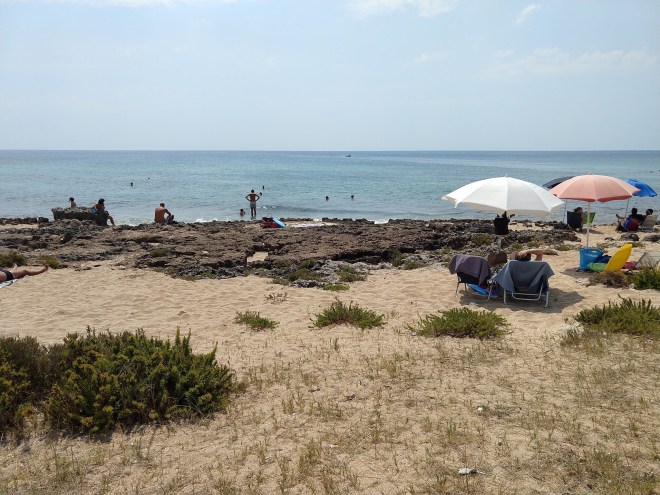
Our view for the afternoon. When the sun hit the water in the right way, the aquas were unbelievable beautiful.
And finally, a couple of final pictures with good memories attached.
First, below is a very colorful salad made with a homemade blackberry dressing that Kirk whipped up from the mountain berries we’d picked in Greece. The dressing traveled with us through several cities and it was quite delicious (and beautiful – it added a nice purple to an already colorful plate!)
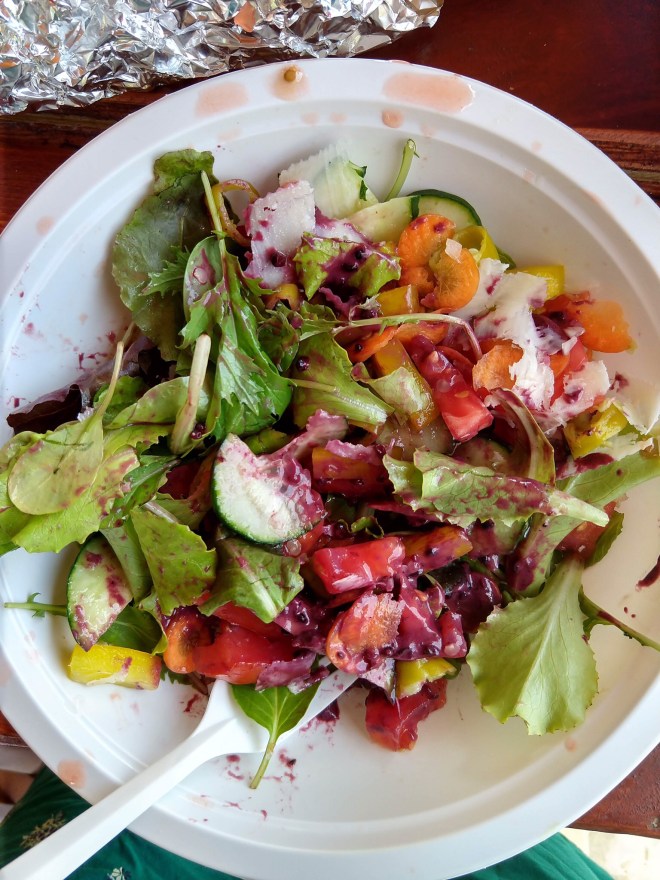
Salad with our homemade wild blackberry dressing
Second, and lastly, a picture of Kirk with our big bags. Because I’ve been having back problems for the last couple of months, Kirk made me stop carrying my own bag and is now carrying both big bags anytime we need to get somewhere (I wear both small bags which weigh significantly less). This day he walked nearly a mile to the bus station with both of those bags while also carrying out freezer and grocery bag. When we later checked our bags to get from Italy to Spain (that’s still a few blogs from now) we found out he’d been carrying around 100 pounds once you included wine and groceries. How amazing is he?

Kirk, with all our heavy stuff
After this mile walk we boarded a bus to Naples, the birthplace of pizza and neighbor of Pompeii. That’s where our next blog begins!